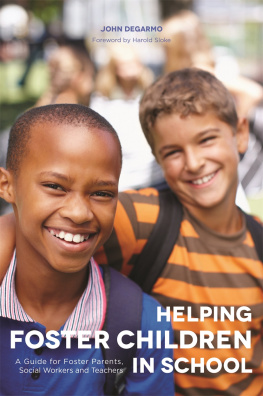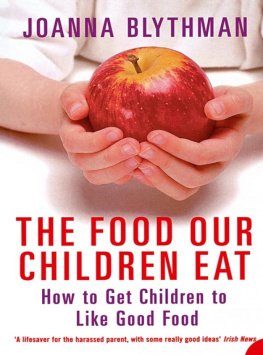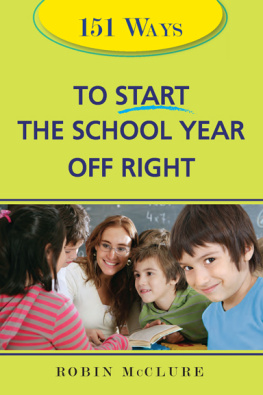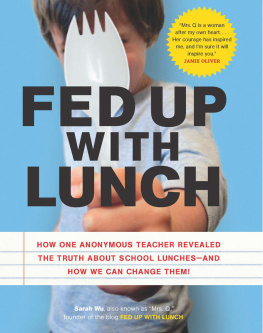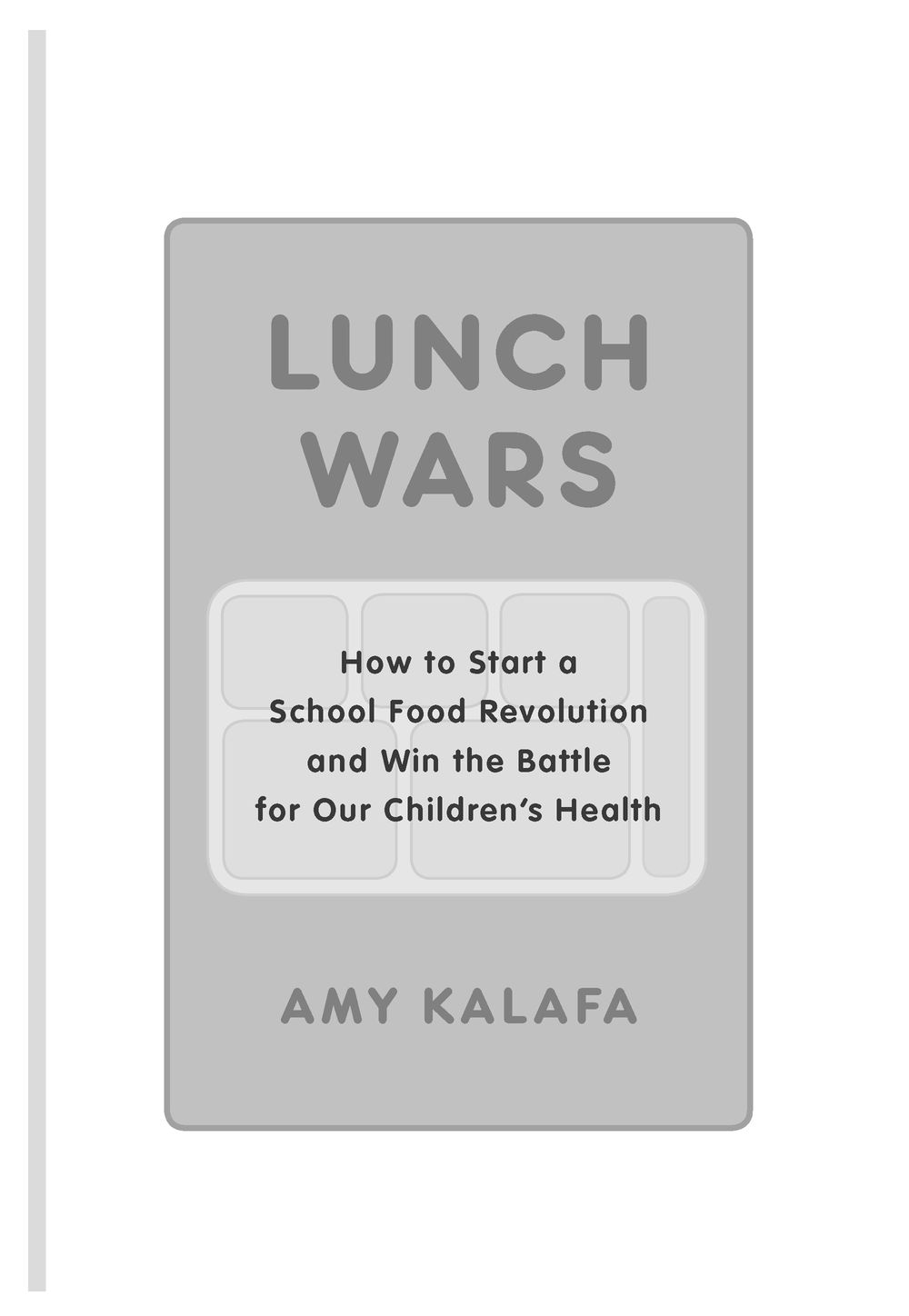Table of Contents
JEREMY P. TARCHER/PENGUIN
a member of Penguin Group (USA) Inc.
New York
You have much more power when you are working for the right thing than when you are working against the wrong thing.
MILDRED LISETTE NORMAN, AKA PEACE PILGRIM
PREFACE
When Im interviewed, Im often asked to share my story. Why did I become so passionate about school food? Ive had to think long and hard to answer this question, because now that Im so involved in the school food movement, its difficult to remember the before!
Like most members of my generation, I grew up on a typical American diet of soda, chips, pizza, Velveeta cheese, steak, chicken, potatoes, and peas. Not nearly as much fast food as todays kids, but Burger King, McDonalds, Kentucky Fried Chicken, and others were a new, cool phenomenon in the sixties and early seventies, and we ate our fair share. In elementary school, we never questioned the food in the cafeteria line. There wasnt a choice of menu items beyond substituting a PB and J for the hot lunch. I recall referring to the meatloaf as barf loaf, and looking forward to a dessert of frosted white cake about one inch square in size. Our simple school meals were cooked by lunch ladies in hairnets, most of whom were related to someone in the lunch line.
I was and still am a highly sensitive person. As a child I was diagnosed with allergies to trees, grass, pollen, synthetic clothing, and other chemicals. I considered myself a closet hypochondriac, never wanting anyone to know how lousy I felt much of the time. Sinus infections, skin eruptions, menstrual cramps, migraine headaches, and fatigue were medicated with progressively stronger tablets and elixirs. My eccentric temperament caused me to believe that I could never have a normal career, so I joined the ranks of the self-employed long before such status became fashionable. As a film and video editor and later as a producer, I was able to hide behind the scenes, creating an alternate reality that did not have to take place in real time. Thus, I could work around my schedule of symptoms.
On this path, I met and married a fellow filmmaker who took me home to meet his family in France. On first impression, I was amazed and somewhat appalled by their apparent obsession with food and drink. Each extended visit required hours around the table several times a day, an experience that made me long for sandwiches chewed over the kitchen sink with my dad when my mother wasnt home.
I had experimented with health food in college; a housemate shared with me during his macrobiotic phase, but in those days, organic was often synonymous with deformed and all that tofu made me gassy. Over time, though, I began to realize that I felt better when I ate my husbands French food (which was also quite delicious). I enjoyed following his mom to the marketa huge open-air plaza with dozens of vendors selling scores of species of seafood, an entire aisle of stalls featuring locally made cheeses, aisles of vivid fruits and exotic vegetables Id never seen before and pastries that were delicate beyond any Id ever tasted in America. Curious, I began learning more about the connection between whole, unprocessed food and health (mine in particular). I also discovered the politics of food in America. I learned that our food system is one of the major causes of global warming. I realized that farm-fresh, chemical-free, whole, unprocessed food was not only good for me, it was healthier for the planet, and probably better for lots of other people as well.
Eventually, my husbands gourmet obsession merged with my awakening sustainability obsession. In 1985, with a friend, we purchased a defunct dairy farm in Bovina, New York, and soon launched the first certified organic poultry and game bird operation on the East Coast, while maintaining our other life as filmmakers in New York City. Then along came the kids; our two girls were raised on mostly organic and homegrown whole foods. My husband packed the girls a homemade lunch for school most days, and neither of us gave much thought to the food served in the school cafeteria. Periodically, I would try to sell my various television network employers and friends on the idea of a program on food, the environment, health, and politics. Its just not sexy was the typical refrain.
My food world and my film world intersected but never meshed until December 2004, when an assignment for Martha Stewart Living sent me to the exclusive Ross School in Easthampton, Long Island. At the Ross School I met chef Ann Cooper, who had been lured from a white tablecloth restaurant in Vermont to run the schools wellness program. Ann coined an acronym for the schools food: Regional, Organic, Seasonal, and Sustainable (ROSS). Meeting Ann Cooper was an epiphany for me. The day of our interview I told her Id be back to make a documentary about school food.
I spent many months researching the chemistry, sociology, and politics of industrialized food. I learned how dramatically our food supply has changed in the past fifty years. The processing and commodification of food in America have resulted in abundance and affordability, but like a balloon squeezed at one end, theres an opposite impact at the other. American kids are often overfed, yet undernourished. Studies, books, articles, and my own experience convinced me irrefutably that there is a link between childhood consumption of junk food not only with obesity and diabetes, but also with other health, learning, and behavioral disorders in children. My passion became more than a personal interest; I felt strongly that the American system of food production and distribution was a political issue affecting every child in America, and that schools had to play an important role in it.
School food is a reflection of American food policy and food culture in general. Since school is where we teach our kids what we think they need to know to be prepared for the future, I felt there was a huge missed opportunity to include real food education in the curriculum as well as in the cafeteria. I wanted to reach as large an audience as possible with my message that we need to examine our food culture, that this isnt just about cupcakes and childhood obesity. Every controversy has a bad guy, and the food industry PR firms had been quick to point fingers at parents. I wanted to counter the spin and point a finger back at the industry. I felt powerless as a parent to have any impact locally or nationally, and I wanted to know what I could do. I wanted to find out what was being done, and what could be done, to change policies and implement programs that provide better food and better food education for children.
I hadnt actually been in a public school lunchroom in years, so one of the first places I filmed was my daughters middle school cafeteria. Reading the labels on the many packaged products for sale confirmed my worst suspicions: the school cafeteria was a microcosm of American fake food culture. Healthy-sounding products like Nutri-Grain bars had high fructose corn syrup listed as one of the first ingredients (well hidden under a foil flap that you had to fold down to read the tiny print!). The low-fat yogurt also had high fructose corn syrup, aspartame (artificial sweetener), artificial flavoring, and coloring. I asked the food service representative to show me how the computerized checkout system worked. She produced a readout of my daughters purchases over the year and thats how I became an angry mom. We had put money on account in the cafeteria for days when our daughter might forget her lunch, or when we might be running too late to pack one for her. I was truly shocked to discover that she had been purchasing fries, Rice Krispies Treats, Pop-Tarts, and soft drinks on a daily basis. No wonder her lunches often came home half-eaten.


